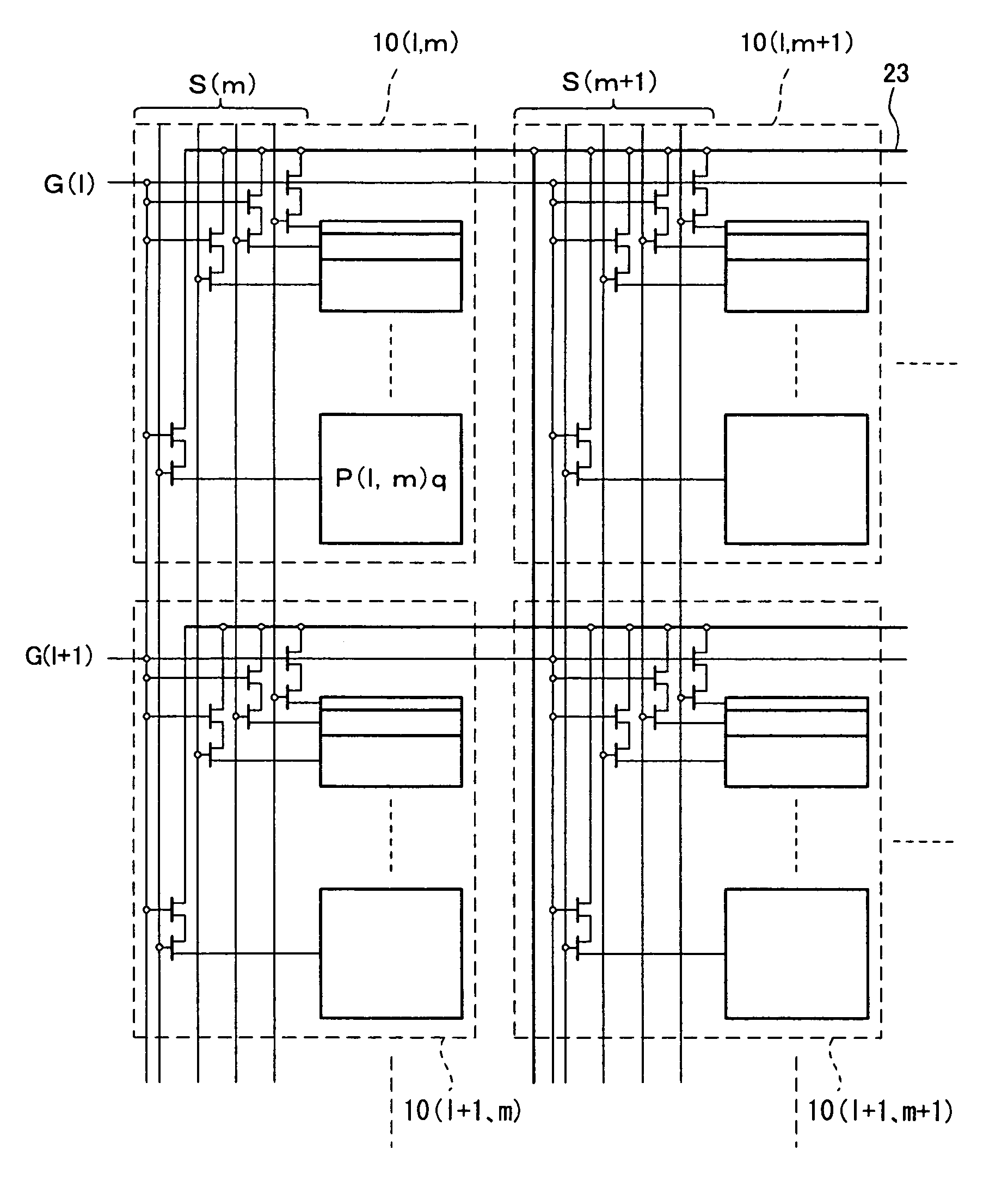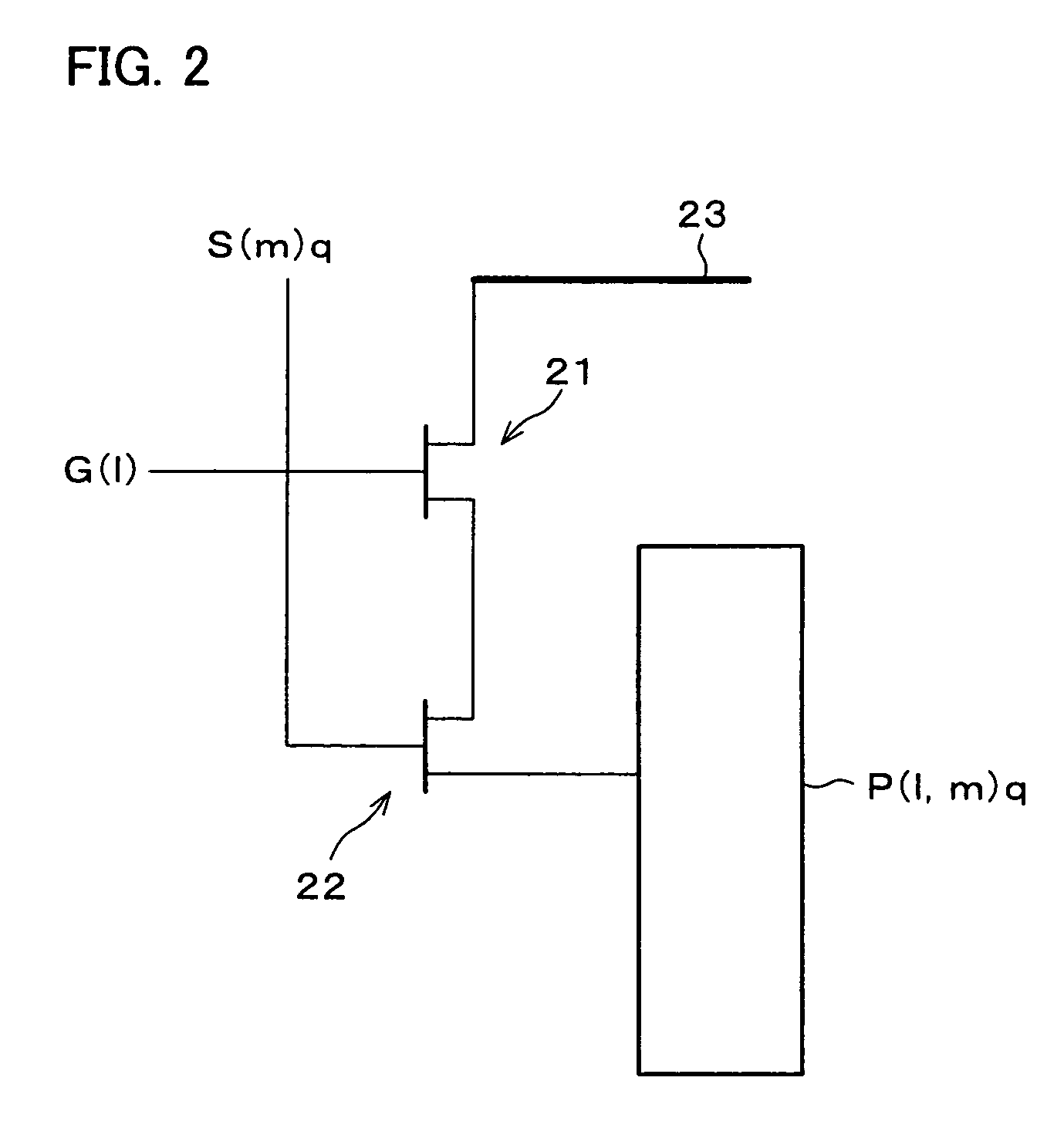Liquid crystal display
a liquid crystal display and display technology, applied in the field of liquid crystal display, can solve the problems of inability to solve second problem, insufficient charge of pixel b>2/b>, etc., to achieve uniform image reproduction, improve the speed of electric charge, and high impedance
- Summary
- Abstract
- Description
- Claims
- Application Information
AI Technical Summary
Benefits of technology
Problems solved by technology
Method used
Image
Examples
first embodiment
[0024]The following will describe a liquid crystal display of the present embodiment with reference to FIGS. 1 and 2.
[0025]The liquid crystal display of the present embodiment is an active matrix liquid crystal display adopting TFT (Thin Film Transistor) elements.
[0026]In the active matrix liquid crystal display, as FIG. 1 shows, liquid crystal is changed between a pair of transparent substrates (not illustrated), and pixels 10 are disposed in a matrix manner. Further, the liquid crystal display of the present embodiment reproduces images by means of an area ratio gray scale.
[0027]On one of the pair of substrates, as illustrated in FIG. 1, scanning signal lines G(l) (l=0, 1, 2, . . . ) to which scanning signals are serially supplied from a scanning signal line drive circuit (not illustrated) and data signal lines S(m) (m=0, 1, 2, . . . ) to which data signals are serially supplied from a data signal line drive circuit (not illustrated) are provided in an orthogonal manner. In the vi...
second embodiment
[0041]This embodiment will describe an example of a color liquid crystal display with reference to FIGS. 2–4. By the way, members having the same functions as those described in First Embodiment are given the same numbers, so that the descriptions are omitted for the sake of convenience.
[0042]As FIG. 3 indicates, a liquid crystal display of the present embodiment is identical with the liquid crystal display of First Embodiment, except that the display of the present embodiment includes picture elements 24 each made up of three pixels corresponding to red (R), green (G), and blue (B). Note that, the sub-pixels in each pixel are identical with those of First Embodiment shown in FIG. 2. In the present embodiment, furthermore, data signal lines connected to the respective pixels (R), (G), and (B) of one picture element 24 constitute a single data signal line S(0) (or S(1) . . . ). Also, the pixels of the liquid crystal display, which are connected to one scanning signal line, are also c...
third embodiment
[0048]Next, another example of the color liquid crystal display will be discussed with reference to FIGS. 5 and 6. By the way, members having the same functions as those described in First and Second Embodiments are given the same numbers, so that the descriptions are omitted for the sake of convenience.
[0049]The liquid crystal display of the present embodiment is, as in FIG. 5, includes picture elements 24 each made up of three pixels corresponding to red (R), green (G), and blue (B), as in the case of the liquid crystal display 2 in Second Embodiment. In this manner, to reproduce color images, a black mask and R, G, and B color filters are provided on a substrate on which sub-pixel electrodes are not provided, and the black mask and R, G, and B color filters correspond to respective pixels. In the present liquid crystal display, furthermore, pixels connected to one scanning signal line are alternately connected to a TFT common line 23a and a TFT common line 23b in the direction pa...
PUM
 Login to View More
Login to View More Abstract
Description
Claims
Application Information
 Login to View More
Login to View More - R&D
- Intellectual Property
- Life Sciences
- Materials
- Tech Scout
- Unparalleled Data Quality
- Higher Quality Content
- 60% Fewer Hallucinations
Browse by: Latest US Patents, China's latest patents, Technical Efficacy Thesaurus, Application Domain, Technology Topic, Popular Technical Reports.
© 2025 PatSnap. All rights reserved.Legal|Privacy policy|Modern Slavery Act Transparency Statement|Sitemap|About US| Contact US: help@patsnap.com



